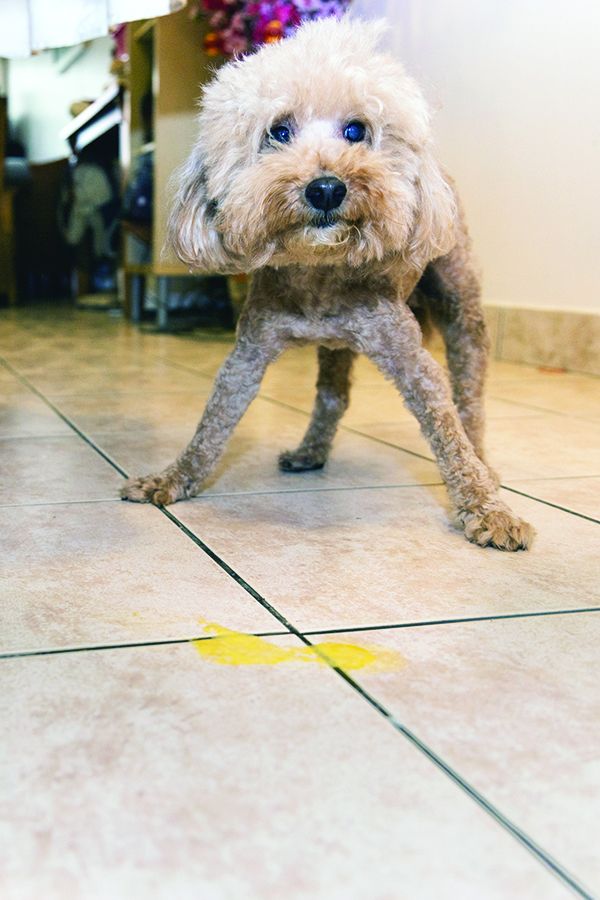Some dogs are prone to vomiting either first thing in the morning or in the wee hours of the night. It’s usually just a small amount of vomit, typically yellowish in color and somewhat frothy or foamy. And it’s more common in younger dogs.
I’ve always called it empty-stomach bile vomiting. The medically correct name for it is “bilious vomiting syndrome.” The word “bilious” comes from the Latin billis (bile) and ous (having or full of). Bile is a fluid that is produced by the liver and secreted into the upper part of the small intestine, where it aids digestion. Sometimes, however, bile backs up into the stomach, inflaming the stomach lining.
This all sounds terrible, but to be honest, the worst thing about the term bilious vomiting syndrome is the word syndrome. When medical professionals use the word syndrome, it generally means we have no idea what causes it. If we know what causes a problem, it’s a lot easier to prevent and treat.
Theoretical Causes of Your Dog Puking Yellow Bile
The certain cause of bilious vomiting syndrome is unknown, but veterinary medical science has some theories. The most widely accepted theory is that a combination of decreased stomach motility and a weak sphincter muscle between the stomach and small intestine allows bile from the small intestine to essentially backwash into the stomach and sit there. Bile is supposed to be in the small intestine, and it causes no problems there. It is not supposed to be in the stomach. When it is, it’s very irritating to the stomach lining, resulting in vomiting.
Other Causes of Your Dog Throwing Up Yellow
But because vomiting is a symptom associated with many other conditions, it is important to rule out any underlying diseases before attributing it to bilious vomiting syndrome.
The list of differentials for chronic vomiting is long. We’ll mention a few here, but this list is not meant to be all-inclusive:
- Addison’s disease (underactive adrenal glands)
- Cancer
- Food allergy
- Gastric foreign bodies
- Gastritis/ulcers (can be secondary to things like nonsteroidal anti-inflammatory drugs [NSAIDs], stress, mast cell cancer)
- Helicobacter (bacteria thought to cause chronic vomiting)
- Hiatal hernia (stomach sneaks up into the chest)
- Inflammatory bowel disease (IBD)
- Intestinal parasites
- Pancreatitis
- Physalopterosis (a stomach worm dogs can get from eating crickets, especially in the Midwest)
- Slow-moving intestinal foreign bodies
The medical workup to rule out underlying issues like these starts with a physical exam. Helpful blood tests might include blood chemistry, complete blood count, baseline cortisol (for Addison’s disease), canine pancreatic lipase (CPL, for pancreatitis), and, to rule out IBD and other gastrointestinal (GI) issues, a fasted blood panel (comprised of cobalamin, folate, trypsin-like immunoreactivity [TLI], and pancreatic lipase immunoreactivity [PLI]).
Other tests that may be needed to solve mysterious, chronic vomiting include fecal exam, chest/abdomen x-rays, abdominal ultrasound, endoscopy, and biopsy. Obviously, your dog may not need all these tests, depending on preliminary test results.
To rule out food allergy, a diet trial with a hydrolyzed protein diet is usually recommended. (Fortunately, a diet trial for food allergy that causes GI upset requires only 10 to 14 days; in contrast, diet trials for skin allergies must be done for a grueling eight to 12 weeks.)
Physaloptera, the stomach worm, is usually not found on a routine fecal test for parasites. If your veterinarian thinks this is at all a possibility, empiric treatment may be recommended. (Endoscopy is usually necessary to find this worm, which is a pretty aggressive, invasive test for a condition that is not that high on the list.)
Similarly, an infection with the Helicobacter pylori bacteria can be hard to diagnose. Empiric treatment may or may not be recommended by your veterinarian, depending on level of suspicion.
Treatment of Bilious Vomiting Syndrome

Photo Credits: Sanja Grujic/ Dreamstime.com
Once it’s been determined that your dog likely suffers from bilious vomiting syndrome, it’s time to try to make it better. I recommend changing one thing at a time, in case that one simple step will resolve the issue. If one step alone doesn’t resolve it, continue and add the next step. The solution might involve a combination of all the steps.
Step 1: Feed a small meal at bedtime. For small dogs, just a biscuit at bedtime might suffice. The idea is that food in the stomach increases gastric motility and will buffer any bile that sneaks in. If that doesn’t work, add Step 2.
Step 2: Divide the dog’s daily food allotment into multiple small meals throughout the day. The idea is to stimulate the stomach into continuous motility, thus preventing bile from seeping backward into the stomach. If those two things don’t work, add Step 3.
Step 3: Add an acid-reducer like omeprazole (Prilosec). Omeprazole is usually dosed twice a day, but after the first week you can give just one dose at bedtime. Sometimes you can even get to every other night dosing with omeprazole. Famotidine (Pepcid) can also be tried (and it kicks in faster than omeprazole), but tolerance to famotidine develops over time, making it less effective in chronic situations like this.
Step 4: If those three things don’t work, I usually add a “prokinetic” medication (which increases gastric motility). Metoclopramide (Reglan), cisapride, or low-dose erythromycin are medications your veterinarian may prescribe. When prescribed for other issues, metoclopramide is typically dosed three times a day. For bilious vomiting syndrome, usually just one dose at bedtime is all that is needed.
If those four things don’t work, add Step5.
Step 5: Ask your veterinarian about adding a gastroprotectant (which may make the stomach less sensitive to the bile irritation). Sucralfate (Carafate) is usually prescribed for this.
The good news: Bilious vomiting syndrome is considered a benign condition. It must be uncomfortable for your dog, however, and cleaning up vomit every day certainly isn’t fun for you. We hope these tips will help you eliminate this unpleasant, chronic condition.







Very informative. Thanks. My Shih Tzu dog whose a year and 9 months old has recently started puking some bile, occasionally a little food during the early hours of the morning. He’s otherwise playful eats well and does not vomit during the day. Has his last meal at 7.pm. At bedtime I give him a very small quantity of apple stew. Could u suggest a better diet before bedtime.? His lunch and dinner consists of 75 grams of fat free mince beef, 3 spoonful of boiled rice mixed veggies carrots pumpkin and some fresh home made plain yogurt. For breakfast he has one grated hard boiled egg and a few pieces of fresh fruits. Water melon Papaya or a small piece of banana. Is there anything in his diet I should change to prevent him from puking bile.? He’s allergic to gluten and chicken. Presently his vet has put him on Pantop 40.half a tablet with his dinner. Does not allow me to pop it into his mouth. Shall greatly appreciated if u could suggest the correct treatment and diet. By the way, his vet has also started him on Neutrolin B 12 ml once a day in his meal.